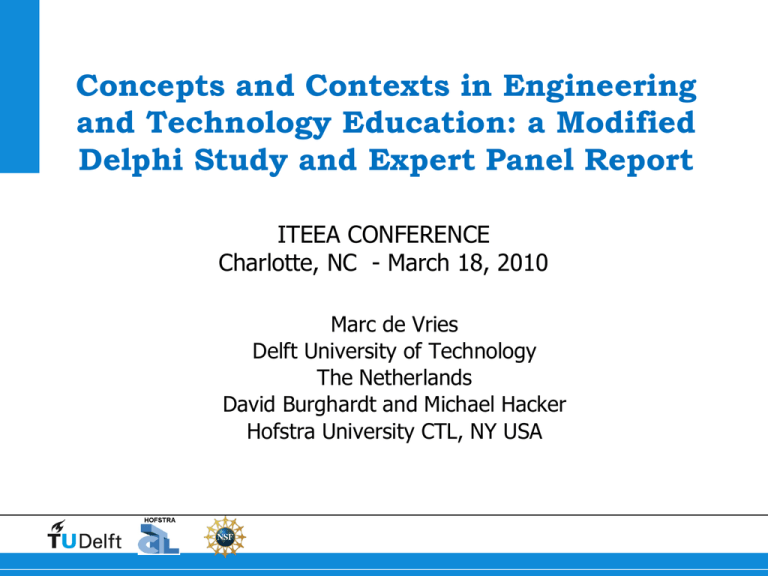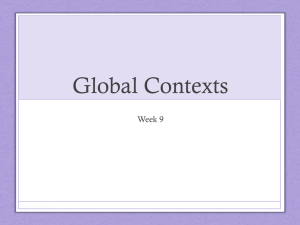PowerPoint-presentatie
advertisement

Concepts and Contexts in Engineering and Technology Education: a Modified Delphi Study and Expert Panel Report ITEEA CONFERENCE Charlotte, NC - March 18, 2010 Marc de Vries Delft University of Technology The Netherlands David Burghardt and Michael Hacker Hofstra University CTL, NY USA Context of the study: a continuing concern • International development of technology education • 100-year transition from a craft-oriented subject to ETE Crafts Industrial Arts Industrial Technology Technology Education ETE • Demands closer relationships with math, science and engineering • Demands a sound conceptual base • • • • • Calling in help from experts Technology Education Philosophy of technology/design methodology History and sociology of technology Engineering Efforts to develop a conceptual framework • UK: many design-dominated flowcharts (but where is the engineering content?) • France: industry-dominated flowcharts (limited view of technology) • Germany: systems-dominated schemes (but where is the process of technology?) • Netherlands, New Zealand and other countries: integration of approaches (often without explicit set of core concepts) • Many countries still: lack of coherence • USA: Standards for Technological Literacy (very extensive, but without ‘nucleus of essentials’) • Earlier efforts in engineering education: temporary successes; too far ahead of their time?) • The Man-Made World (Engineering Concepts Curriculum Project, Polytechnic Institute of Brooklyn, NY: (1971) • Principles of Engineering, NYSED (1989) Aim of the CCETE study • To identify overarching, unifying core concepts in engineering and technology that can form the basis for a curriculum • Generalizable over a wide range of ETE domains • Subsume a set of related subconcepts • To identify contexts that can be used for teaching and learning those concepts • Research shows that concepts should be taught in engaging contexts Earlier beliefs: teach general concepts and learners will be able to apply in any context; learn in one context, generalize and transfer to other contexts. More recent thinking: learn in variety of contexts and gradually general conceptual understanding emerges and can be applied to new contexts • Still a debate: What is a ‘context’? Researchers, timeframe • The study was funded by the US National Science Foundation’s MSTP Project • Study was done in cooperation by • Ammeret Rossouw (Delft University of Technology) • Michael Hacker (Hofstra University) • Dr. Marc J. de Vries (Delft University of Technology) • The study was done in May-July 2009 • A panel discussion to reconcile results took place on August 5 and 6, 2009 at Hofstra University Nature of the study • Delphi study • Analogous: Osborne et al. (2004) for science education • Three rounds of expert consultation • Followed by panel meeting (August 5-6, 2009) • Experts from a range of disciplines • Technology (teacher) education • Engineering education/engineering organizations • Philosophy and history of technology/design methodology • International group of experts • Australia, Germany, Hong Kong, India, Israel, Netherlands, New Zealand, UK, USA • Concepts and Contexts Characteristics of a Delphi study • Combine experts’ opinions without possibility of bias because of personal dominance in meeting • Output of previous round is input for next round: experts see the average scores and can adapt their own scores • Strive for consensus (with stability) • Usually consensus in three or four rounds • If not: seek out differences between sub-groups • Methodologically, a bit weak, but not controversial (this was a modified Delphi) Experts Philosophy and History of 5 Technology, Science Communication Engineering Education and Engineering Organization 8 Technology (Teacher) Education 21 Total 34 Round 1 • List of possible concepts and contexts to show to experts the type of concepts and contexts we aim for • Opportunity to generate other concepts and contexts • Opportunity for general comments • Data processing • List separately when two or more experts propose concept/context • Try to deal with as many suggestions as possible by adding concepts as sub-categories in concept list • Same for contexts, but more loose on listing contexts separately Final results: concepts Final result: concepts (cont.) Remarks • Concept of ‘function’ made a drop from round 2 to round 3 • Concept ‘working principles’ and ‘modularity’ rejected but not entirely by consensus • Strong supportive individual opinions on ‘practical reasoning’, ‘complexity’ and ‘algorithms’ • Include as sub-concepts? Final result: contexts Final result: contexts (cont.) Observations • Contexts generally gave more rise to disagreement than concepts • ‘Medical technologies’ accepted but not entirely by agreement • Draws to medical schools rather than to engineering? • Disagreement about ‘nanotechnology’ • Too difficult to put into practice? • Trend among experts to stick with the traditional? • Construction, production, transportation, communication • Plus biotechnology • New trend: seek for ‘big social issues’ • Food, water, health, sustainability • “Make the world a better place” Panel discussion • Aim • Add structure/hierarchy to the concept and context lists • Make suggestions for next steps • Contexts • Panel recognized two types of contexts • Traditional: (i.e., construction, production, transportation, communication, biotechnology) • Global concerns: energy, water, food, health, security, sustainability • Panel proposed one list that comprises both and is based on human needs Panel discussion (cont.) Concepts • Panel identified concepts of primary and secondary level of abstraction • Primary: Design (as a verb), systems, modeling, resources, human values • Remaining concepts can all be put under these main headings; • Higher ones on the Delphi list can be mentioned as examples with higher ‘status’ Next Steps - Contexts Consolidating the contexts in a way that reflects issues relating to personal, societal and global concerns Food (e.g., agriculture, biotechnology) Shelter (e.g., construction), Water (e.g., supply and quality) Energy (e.g., production, distribution) Mobility (e.g., transportation) Production (e.g., manufacturing) Health (e.g., medical technologies) Security (e.g., firewalls) Communications (e.g., Internet, satellite Next Steps – Curriculum Elaborate into curriculum When developing a curriculum, the contexts should be elaborated in two directions: • personal concern (or “daily life practice”) direction • global concern direction. Include both qualitative and quantative elements Next Steps – Themes • Design (e.g., optimization, trade-offs, specifications) modeling (e.g., representation and prediction) • Systems (e.g., function, structure) • Resources (e.g., materials, energy, information) • Human values (e.g., sustainability, innovation, risk, failure, social interaction). Next Steps – Framework Next Steps – Sequencing Instruction There is much to do in terms of deciding what is needed at different grade levels. How does one discuss systems, in the context of water, with a 7-year-old? What is the discussion like with a 15-year-old? Who are the teachers? Mobility – HS Auto Safety Example Theme Driver Vehicle Road Regulations Design a system to activate brakes in if driver falls asleep. Design a system to measure the effect of temperature on brake reliability. Design, build, and test various impact attenuators for model cars hitting a barrier. Design, build, and test improved road signs and systems to monitor/control speed. Using models of various vehicles, determine CG and effect on stability. Resources Determine the kind Investigate use of of information clean energy that should be sources, and available to drivers recyclable materials while driving for use in cars. Determine the effect of various radii of curvature of turns on car stability. Choose appropriate road construction materials based on student-established criteria. Model a traffic intersection from real data. Systems Design traffic light system so that yellow light does not result in a dilemma zone. Community decides where to install traffic signals. Explain how police radar systems work. Design Modeling Graph drivercaused accidents from real data. Human Values Measure reaction time needed to provide feedback for braking Driver decisions re: drinking and driving Explain how backup alarm systems provide r. feedback. Installation of breathalyzers linked to ignition systems Discuss what role government has in establishing limits on use of non-renewable resources for cars. Government regulation of speed limits and MPG requirements. Thank you for your kind attention Download the full report at: http://www.hofstra.edu/pdf/Academics/Colleges/SOEAHS/ctl/CTL_Edu_Initiatives_%20CCETE.pdf








